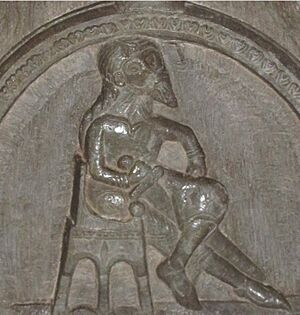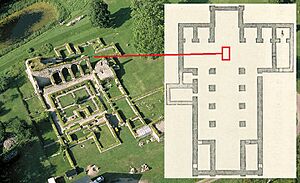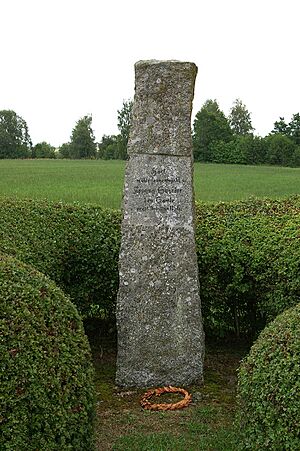Sverker the Elder facts for kids
Quick facts for kids Sverker the Elder |
|
|---|---|
 |
|
| King of Sweden | |
| Reign | c. 1132 – 25 December 1156 |
| Predecessor | Magnus I |
| Successor | Eric IX |
| Born | c. 1100 |
| Died | 25 December 1156 Near Alvastra, Sweden |
| Spouse | Ulvhild Håkansdotter Richeza of Poland |
| Issue | Charles VII John |
| House | Sverker |
| Father | Cornube |
Sverker the Elder (born around 1100, died December 25, 1156), also known as Sverker I, was the King of Sweden. He ruled from about 1132 until he was killed.
Sverker was not born into a royal family. He started the House of Sverker, which was a powerful family. For the next hundred years, kings from his family and the rival House of Eric took turns ruling Sweden.
Contents
How Sverker Became King
Sverker was a rich landowner from a part of Sweden called Östergötland. His father's name was likely Cornube or Kol. He became powerful after the old royal family, the House of Stenkil, ended in the 1120s.
A Danish prince named Magnus the Strong was king in another part of Sweden for a short time. But Magnus became busy with wars in his home country, Denmark. This gave Sverker a chance to become king.
Around 1132, the Swedish people chose Sverker as their king. They did this because they did not want a foreign ruler.
Becoming a Stronger King
It took some time for all parts of Sweden to accept Sverker as their king. In the 1130s, some areas, like Västergötland, still wanted to be separate. A local leader there was even called "king" in some records.
By 1135, Sverker was accepted in the areas around Lake Mälaren. He even helped a Danish prince named Oluf Haraldsen. By the 1140s, most of Sweden recognized Sverker's rule. His power came from the central area of Östergötland. Important churches and monasteries there, like Alvastra Abbey and Vreta Abbey, also supported him.
Sverker made his rule stronger by choosing his wives carefully. First, he married Ulvhild Håkansdotter. She had been married to the last king of the old royal family. This marriage helped Sverker gain support and land from that family.
After Ulvhild died, Sverker married Richeza. She was the widow of his old enemy, Magnus the Strong. This marriage helped him get support from Magnus's followers. Richeza's daughter, Sophia of Minsk, later married Valdemar the Great of Denmark. This created an important link with Denmark.
Helping the Church
Sverker greatly supported the Church. He invited a group of monks called the Cistercians to Sweden. His first wife, Queen Ulvhild, helped with this. These monks built several important monasteries:
- Alvastra Abbey in Östergötland
- Varnhem Abbey in Västergötland
- Nydala Abbey in Småland
Sverker also wanted Sweden to have its own archbishop. An archbishop is a very important church leader. In 1152, a papal delegate (a representative from the Pope) named Nicholas Breakspear visited Sweden. Sverker welcomed him. They likely agreed to start collecting "Peter's pence," which was a tax for the Pope.
However, the plan for a Swedish archbishop did not happen right away. The people of Sweden could not agree on where the archbishop's seat should be. So, Nicholas Breakspear did not give them this honor. Sweden finally got its own archbishop in 1164, after Sverker's death.
Sweden's Relations with Other Countries
For a long time, Sweden had good relations with Russian areas. But during Sverker's rule, things changed. In 1142, Swedish forces went to the Finnish Gulf with 60 boats. They attacked a group of traders. This was the first known fight between Sweden and the Republic of Novgorod. It ended a long period of peace.
A bigger conflict happened in the 1150s. Sverker helped his stepson, Canute V, who was having trouble in Denmark. This support angered Canute's rival, Sweyn III of Denmark.
King Sweyn decided to invade Sweden in 1153. He went into the forested area of Småland. Sverker did not fight him directly. Instead, the local people fought back fiercely. They ambushed the Danish soldiers. The war was fought in the cold winter. Many Danish horses died.
Even though some local people gave up, Sweyn had to sneak back to Denmark in early 1154. Some of his soldiers were even tricked by villagers and killed. This war ended quickly.
Sverker continued to support Canute V. Canute and another Danish prince, Valdemar, visited Sverker in 1154. They wanted to form an alliance through marriage. Sverker's daughter, Helena, became engaged to Canute V. This alliance helped Canute and Valdemar successfully attack Sweyn III later that year.
Sverker's Death
Sverker was killed on Christmas Day, 1156. He was in his coach, going to church near Alvastra. His own trusted servant was the one who killed him. This was seen as a very shocking crime.
Some people believe that a Danish prince named Magnus Henriksson secretly made the servant do it. Magnus wanted to become king himself. After Sverker's death, Eric the Saint became king in some parts of Sweden. Sverker's son, Charles VII, later became king in Östergötland around 1158.
Sverker's Family
Sverker had children with his two wives and possibly another woman.
By his first wife, Queen Ulvhild:
- Son John (Johan or Jon jarl), who was killed by angry peasants in the early 1150s.
- Son Charles, who became king after Sverker.
- Daughter Ingegärd (died in 1204), who became a prioress (leader) at Vreta convent.
- Daughter Helena of Sweden (her name is not fully certain), who married Canute V of Denmark.
By his second wife, Queen Richeza:
- Son Boleslaw, who might be the same person as Burislev of Sweden.
Sverker also had a son named Sune Sik, who was thought to be born around 1154. It is not known who his mother was.
See also
 In Spanish: Sverker I para niños
In Spanish: Sverker I para niños



